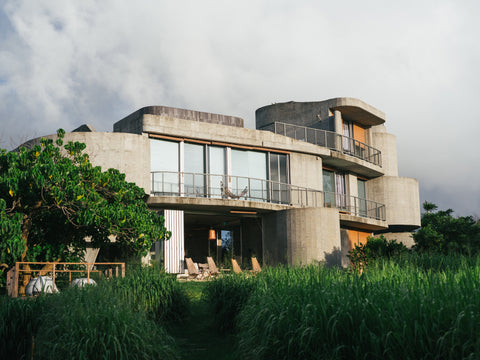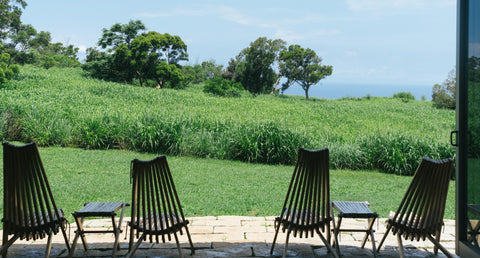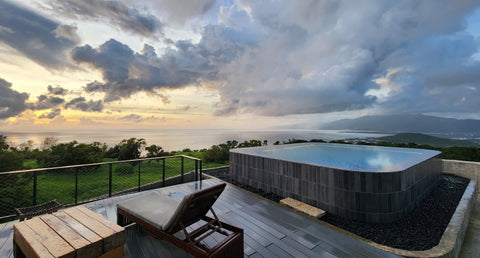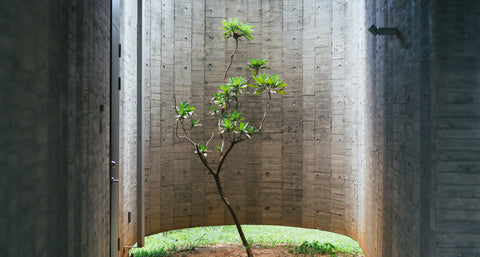PLACE
Wandering in the Wilderness
Slow down at Wandering Walls, a retreat on the edge of an acacia forest in Kenting, Taiwan.
Photography by Sean Marc Lee
Nestled on a mountain ridge on the northwest side of the Hengchun Peninsula in Taiwan, Wandering Walls is defined by its raw concrete structure with billowing walls seemingly flowing with the wind. Rather than dominate the landscape, the architecture blends with the natural environment.
There is no signage on the single pathway up—only endless greens and a cloudless blue sky—signalling that one has entered the realm of nature to enjoy its untarnished magnificence in peaceful solitude.
The discovery of the otherworldly terrain that Wandering Walls sits on traces back to the founder’s story. Originally a civil engineer, Gavin Chiu had planned to further his education in America before returning to Taipei to follow a predetermined path and live as an office worker. Before starting his MBA, he took a six-month sabbatical and embarked on a world tour. During his travels, he was deeply moved by the indigenous people he encountered, who, despite their material poverty, seemed happier than the salarymen he saw in the cities. This experience led him to rethink his ideal life.

Returning to Taipei, Chiu continued working while searching for land where he could build a retreat and live a simpler, happier life closer to nature. Having loved the scenic landscapes of Kenting since childhood, he considered the southern tip of Taiwan an ideal choice. Alone on his motorbike, he scoured the peninsula during his off days, looking for land he felt an affinity with and could afford. His search led him to the remote northwest, which remains relatively untouched—the nearest village is at least 1.5 kilometres away.
The remoteness also meant the land had no water source, electricity supply, or access road. Everything had to be built from scratch. The many challenges Chiu faced included a shoestring budget (his savings), a lack of skilled construction labour, and learning and understanding the ways of the village having lived in the city his entire life. Despite all that, Chiu was determined to create a retreat that was context-sensitive and respectful to the land.

A long-term follower of XRANGE Architects’ work, Chiu enlisted its founder and architect, Grace Cheung, to design the retreat. When he brought Cheung to see the site, she was captivated by its raw beauty. Her first encounter with the surrounding acacia trees and tall grasslands was underscored by a symphony of swaying forest—a result of the Hengchun downslope wind or ‘恆春落山風’, a meteorological phenomenon where wind descends from the Central Mountain Range to the south. Like Chiu, she felt a profound responsibility to preserve the land’s magical wilderness.
The eight-room retreat occupies only a small portion of the terrain, with the rest left sensibly untouched, prioritising harmony with the landscape over maximising returns. Despite the modest build, the architectural design is no less creative. In place of rigid pillars and columns, wandering walls dance on the periphery of the native acacia forest that offers natural wind shelter. Left unpolished, the cement walls have smoothened over time by the force of the seasonal winds.


The fluid design creates ample opportunities to let the outdoors in, featuring pockets of echo chambers that amplify the sounds of rustling leaves and cicada songs, open vistas that frame majestic sunset views over the ocean, and ever-changing wild grasslands under starry nights. Migrating birds can also be spotted once a year.
It took an arduous decade to bring Wandering Walls, Chiu’s dream, to fruition. This labor of love was driven by a shared vision to preserve the land while creating a one-of-a-kind retreat. To this day, Chiu tirelessly runs the place, maintaining relationships with the villagers, overseeing property repairs, managing his organic farm, and even cooking for guests. This land is his life’s work.













